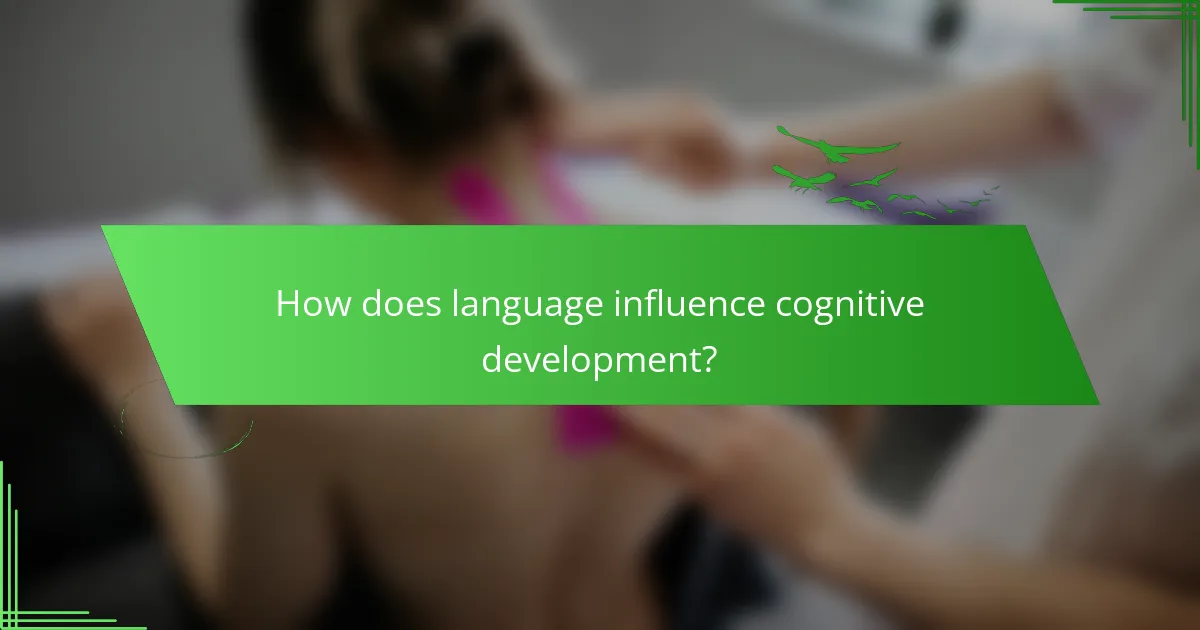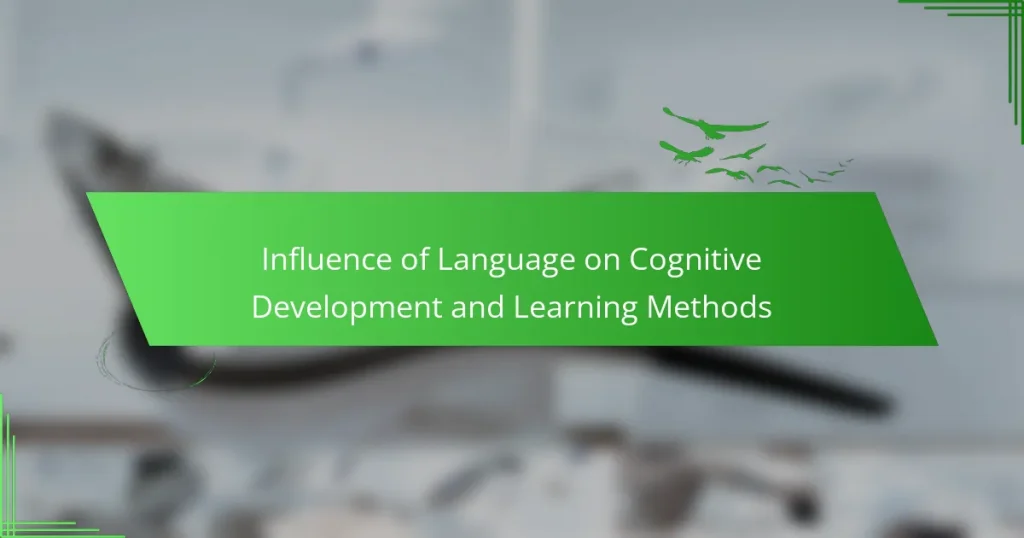Language plays a crucial role in cognitive development and influences learning methods. It shapes thought processes, enhances memory retention, and fosters critical thinking skills. Bilingualism can improve cognitive flexibility and adaptability in learning strategies. Cultural context further affects language acquisition and educational approaches, highlighting the diverse impacts of language on cognition.

How does language influence cognitive development?
Language significantly influences cognitive development by shaping thought processes and learning methods. It facilitates complex reasoning, problem-solving, and social interactions.
Research indicates that bilingualism enhances cognitive flexibility and executive function. Children exposed to rich language environments exhibit superior vocabulary and comprehension skills. Additionally, language serves as a tool for organizing experiences, enhancing memory retention.
Cultural context plays a unique role in shaping language acquisition and cognitive strategies. For instance, different languages may emphasize various cognitive skills, affecting how individuals perceive and interact with the world.
Overall, the interplay between language and cognition underscores the importance of fostering language-rich environments for optimal cognitive growth.
What are the key theories linking language and cognition?
Language significantly influences cognitive development and learning methods. Theories such as the Sapir-Whorf hypothesis suggest that language shapes thought processes and perception. Vygotsky’s theory emphasizes the social context of language, proposing that cognitive skills develop through social interactions. Additionally, the linguistic relativity principle indicates that language can affect how individuals categorize and understand their experiences. These theories highlight the complex relationship between language and cognition, showing how language serves as a tool for learning and cognitive growth.
How does bilingualism affect cognitive skills?
Bilingualism enhances cognitive skills by improving problem-solving, multitasking, and memory. Studies show bilingual individuals often outperform monolinguals in tasks requiring cognitive flexibility. Additionally, bilingualism fosters better executive function, allowing for superior attention control and information processing. This cognitive advantage stems from the brain’s increased engagement in managing multiple languages, which strengthens neural pathways.
What cognitive advantages do bilingual individuals experience?
Bilingual individuals experience enhanced cognitive flexibility, improved problem-solving skills, and better multitasking abilities. These advantages stem from the constant mental exercise of switching between languages, which strengthens brain functions. Research indicates that bilingualism can delay the onset of cognitive decline and dementia by several years. This unique attribute highlights the significant impact of language on cognitive development and learning methods.
Are there any cognitive disadvantages associated with bilingualism?
Research indicates that bilingualism does not inherently lead to cognitive disadvantages. Instead, it often enhances cognitive flexibility and problem-solving skills. Some studies suggest potential challenges, such as language interference or slower processing in specific contexts, but these are typically outweighed by the cognitive benefits. For instance, bilingual individuals may experience a slight delay in word retrieval but often excel in tasks requiring executive function. Overall, the advantages of bilingualism tend to overshadow any minor cognitive drawbacks that may arise.

What are the universal attributes of language in cognitive learning?
Language universally influences cognitive development by facilitating thought processes, enhancing memory, and shaping learning methods. It serves as a medium for communication, allowing individuals to express ideas and acquire knowledge.
Key attributes of language in cognitive learning include its role in problem-solving, which enhances critical thinking skills, and its contribution to social interaction, fostering collaborative learning. Additionally, language aids in the organization of thoughts, enabling clearer understanding and retention of information.
The unique attribute of language is its adaptability across cultures, influencing how individuals perceive and interpret their environment. This adaptability can lead to variations in cognitive strategies employed by learners from different linguistic backgrounds.
A rare attribute of language in cognitive learning is its capacity to evoke emotional responses, which can significantly impact motivation and engagement in learning activities.
How does language facilitate memory retention?
Language enhances memory retention by providing structured frameworks for organizing information. This structure aids in encoding and retrieval processes, making it easier to recall facts and concepts.
The use of language allows for the creation of associations, which are essential for memory. For instance, mnemonic devices leverage linguistic patterns to facilitate recall. Additionally, storytelling in language creates emotional connections, enhancing the likelihood of remembering information.
Moreover, language facilitates the categorization of knowledge, allowing learners to group related concepts. This organization helps in understanding and retaining complex information. Research shows that individuals who engage in verbal elaboration demonstrate improved memory performance.
In summary, language serves as a powerful tool for memory retention by structuring information, creating associations, and enabling effective categorization.
What role does language play in problem-solving abilities?
Language significantly enhances problem-solving abilities by shaping thought processes and cognitive frameworks. It provides the tools for articulating complex ideas and reasoning through challenges. Research indicates that bilingual individuals often demonstrate superior problem-solving skills due to their ability to navigate multiple linguistic structures. Language also influences how problems are framed, which can affect the strategies employed to find solutions. For instance, the way a problem is presented can lead to different interpretations and approaches, showcasing the unique attribute of language as a cognitive tool. Overall, the interplay between language and cognition is crucial for effective problem-solving.
How does language shape critical thinking skills?
Language significantly enhances critical thinking skills by shaping how individuals process information. It provides the tools for analysis, evaluation, and synthesis of ideas. The complexity of language encourages deeper cognitive engagement, fostering skills like reasoning and problem-solving. Moreover, diverse linguistic structures can influence thought patterns, leading to unique perspectives and innovative solutions. This interplay between language and cognition highlights the importance of language in educational settings, where critical thinking is essential for effective learning.

What unique features of language impact learning methods?
Language uniquely influences learning methods by shaping cognitive processes and communication styles. The complexity of language, including syntax and semantics, affects how learners interpret information. For instance, languages with rich morphological structures may enhance analytical skills, while those emphasizing context can improve social learning. Additionally, bilingualism fosters cognitive flexibility, allowing learners to switch between different modes of thinking. Understanding these features can lead to more effective educational strategies tailored to individual language backgrounds.
How do cultural contexts influence language acquisition?
Cultural contexts significantly shape language acquisition by influencing cognitive development and learning methods. They affect how individuals interpret and engage with language, leading to variations in learning outcomes.
Cultural norms dictate communication styles, which impacts language learning. For instance, collectivist cultures may emphasize group learning, fostering collaborative language skills. In contrast, individualistic cultures might prioritize self-directed learning, enhancing personal language acquisition.
Additionally, cultural contexts provide unique vocabulary and expressions, enriching the language experience. Learners exposed to diverse cultural contexts develop a deeper understanding of language nuances, enhancing their cognitive flexibility.
Finally, cultural backgrounds influence motivation and attitudes towards language learning. Positive cultural associations can boost engagement, while negative perceptions may hinder progress. Understanding these dynamics is crucial for effective language education.
What is the impact of dialects on cognitive processing?
Dialects can significantly influence cognitive processing by shaping how individuals perceive and interpret information. Research indicates that exposure to diverse dialects enhances cognitive flexibility, allowing for improved problem-solving skills and adaptability in learning environments.
Additionally, dialects contribute to the development of critical thinking by encouraging individuals to navigate multiple linguistic frameworks. This exposure fosters a deeper understanding of context and meaning, which is essential for effective communication and comprehension.
Moreover, the unique attributes of dialects, such as regional expressions and cultural references, enrich cognitive processing by providing diverse perspectives. As a result, learners who engage with various dialects may develop enhanced analytical skills and creativity in their thought processes.
How do different languages affect perception and thought?
Different languages shape perception and thought by influencing cognitive processes and learning styles. Language structures, such as grammar and vocabulary, can affect how individuals categorize experiences and understand concepts. For instance, speakers of languages with gendered nouns may perceive objects differently compared to those without such distinctions. Research indicates that bilingual individuals often exhibit enhanced cognitive flexibility, allowing for diverse problem-solving approaches. This demonstrates the unique attribute of language as a tool that not only facilitates communication but also molds cognitive frameworks.

What rare attributes of language can enhance cognitive development?
Rare attributes of language that can enhance cognitive development include metaphorical thinking, linguistic diversity, and phonetic complexity. Metaphorical thinking allows individuals to make abstract connections, fostering creativity and problem-solving skills. Linguistic diversity introduces varied grammatical structures and vocabulary, enhancing flexibility in thought processes. Phonetic complexity engages auditory discrimination, improving memory and processing speed. These attributes contribute uniquely to cognitive growth, enriching learning experiences and critical thinking abilities.
How does language diversity in a community affect cognitive skills?
Language diversity in a community enhances cognitive skills by promoting critical thinking and problem-solving abilities. Exposure to multiple languages encourages flexible thinking and adaptability. Studies show that bilingual individuals often outperform monolinguals in tasks requiring executive function, such as attention control and working memory. Furthermore, multilingual environments foster creativity and cultural awareness, leading to improved social skills and empathy. These cognitive advantages arise from the unique attribute of navigating different linguistic structures and cultural contexts, which stimulates brain development.
What are the effects of language immersion programs on learning?
Language immersion programs significantly enhance cognitive development and learning outcomes. These programs promote fluency and comprehension by surrounding learners with the target language.
Research indicates that students in immersion settings demonstrate improved problem-solving skills and creativity. They often show better performance in standardized tests compared to peers in traditional language classes.
The unique attribute of immersion programs is their ability to integrate language learning with cultural experiences, fostering deeper engagement. As a result, learners not only acquire language skills but also develop a broader worldview.
Additionally, immersion can lead to increased metalinguistic awareness, enhancing overall cognitive flexibility. This rare attribute contributes to better academic performance across subjects, showcasing the holistic benefits of such educational approaches.

How do learning methods vary across different languages?
Learning methods vary significantly across languages due to cognitive and cultural influences. Different languages shape thought processes, impacting how information is absorbed and processed.
For example, languages with complex grammatical structures may encourage more analytical thinking. In contrast, languages that emphasize context can foster holistic understanding. Research shows that bilingual individuals often exhibit enhanced cognitive flexibility, adapting their learning strategies based on the language used.
Cultural factors also play a role; for instance, collectivist cultures may prioritize collaborative learning, while individualistic societies may emphasize self-directed approaches. This interplay of language and culture creates diverse educational frameworks worldwide.
What teaching strategies are most effective for language learners?
Effective teaching strategies for language learners include interactive activities, scaffolding, and differentiated instruction. These methods enhance cognitive development by engaging students in meaningful communication and adapting to their individual needs.
Interactive activities, such as role-playing and group discussions, promote active participation, which helps reinforce language skills. Scaffolding provides support through gradual skill development, allowing learners to build confidence. Differentiated instruction tailors lessons to accommodate varying proficiency levels, ensuring all learners can engage with the material effectively.
Research indicates that these strategies not only improve language acquisition but also foster critical thinking and problem-solving skills, essential for overall cognitive development.
How does the structure of a language influence its teaching method?
The structure of a language significantly shapes its teaching method by influencing cognitive processes. For instance, languages with rich inflection may require different pedagogical approaches compared to those with simpler structures.
Languages that emphasize syntax can enhance analytical thinking skills, while those focused on phonetics may improve auditory processing. Teaching methods often adapt to these structural aspects, utilizing strategies like immersive learning or phonics-based instruction to align with the language’s inherent characteristics.
Overall, understanding a language’s structure aids educators in developing effective teaching methodologies that cater to the cognitive development of learners.

What best practices can enhance cognitive development through language?
Engaging with language through reading, conversation, and storytelling enhances cognitive development. These practices stimulate critical thinking, improve vocabulary, and strengthen neural connections. For example, interactive discussions encourage problem-solving skills and creativity. Reading diverse materials broadens perspectives and fosters empathy. Storytelling enhances memory retention and comprehension.
What common mistakes should educators avoid when teaching languages?
Educators should avoid common mistakes that hinder language learning effectiveness. Focusing too much on grammar instead of communication can stifle students’ confidence. Neglecting cultural context diminishes engagement and understanding. Additionally, using a one-size-fits-all approach ignores diverse learning styles. Lastly, failing to provide constructive feedback can impede progress and motivation.
How can parents support language development at home?
Parents can support language development at home through interactive reading, engaging conversations, and encouraging expressive activities. Reading together exposes children to vocabulary and sentence structure. Conversations foster critical thinking and comprehension. Encouraging expressive activities, like storytelling or singing, enhances creativity and verbal skills. These methods significantly influence cognitive development and learning outcomes.
What are effective tools for promoting language skills in children?
Effective tools for promoting language skills in children include interactive reading apps, language games, and storytelling activities. These tools enhance vocabulary, comprehension, and communication abilities through engaging methods. For instance, interactive reading apps provide immersive experiences that foster language acquisition. Language games introduce fun competition, motivating children to practice their skills. Storytelling activities encourage creativity and expression, reinforcing language concepts in a memorable way.




